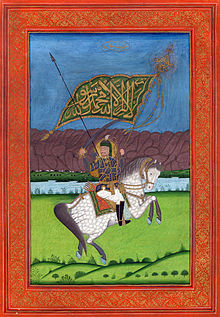al-ʿAbbās ibn ʿAlī
Al-ʿAbbās ibn ʿAlī ( Arabic العباس بن علي, DMG al-ʿAbbās b. ʿAlī , Albanian Abaz Aliu ; * May 15, 647 ; † October 10, 680 near Karbala ) was a Shiite martyr .
Birth, title, family
'Abbas was born on the 4th Sha'ban in the year 26 after the Hijra (around May 647 AD) in the city of Medina . His father was ʿAlī ibn Abī Tālib , who is the first imam for the Shiites and the fourth caliph for the Sunnis . His mother was Fātima bint Hizam al-Kilabiyya (also known as Umm al-Banīn , "mother of the sons"), who married 'Ali a few years after the death of his first wife Fatima bint Muhammad (Fatima the daughter of the founder of the religion Mohammad ). He had three biological brothers: Abdullah ibn Ali, Jafar ibn Ali, and ʿUthman ibn Ali. Hussain ibn 'Ali was his half-brother in particular, but he had other half-siblings as well.
'Abbas is better known by his nickname Abul Fadhl and another nickname is Abu Qasim. In addition, he carried the honorary title “Qamar Bani Hashim” (“Moon of the Hashimites ”) and others.
He married Lubaba bint Ubaydullah . They had two sons together: Fadhl and Ubaydullah. Further sources give further sons who are said to be called Qasim, Muhammad or Hasan. They also had one or two daughters together. There are some shrines that are ascribed to the descendants of 'Abbas, located in the cities of Isfahan , Qom and Zanjan , among others .
'Abbas took part in the Battle of Siffin in AD 657, and it is said that he was brave in that battle.
Battle of Karbala
'Abbas was a devoted follower of his half-brother, the third Shiite imam, Husain ibn' Ali. In the battle of Karbala he was one of the few who remained loyal to him and were killed fighting on his side. For this loyalty he is venerated as a martyr by the Shiites.
Shiite legends that tell of his life emphasize his special loyalty to Husain ibn Ali, which has existed from birth, and that he is the strongest next to his father Ali ibn Abi Talib and his half-brother Husain ibn Ali, from whom he learned the martial art Fighter of all time.
legacy
'Abbas died and was buried in Karbala in what is now Iraq. Today the al-Abbas mosque stands above his burial site and the Imam Husain shrine is not far from it . The Imam Husain Shrine and his shrine are an important place of pilgrimage and are visited by up to over 20 million people from all over the world , especially on the anniversary of the day of Ashura and Arba'in . Mainly Shiites take part, but also Sunnis, Yazidis, Christians and others. Various mourning ceremonies are then held there.
On the Tomorr mountain near the Albanian city of Berat there is a supposed grave and a tekke , the Teqeja e Kulmakut , to which up to ten thousand Albanians of the Sufi Bektashi order make pilgrimages from August 20th to 25th . Abbas Ali's soul, in the belief of the Bektashi, settled on the mountain after his martyrdom before it ascended to heaven.
See also
literature
- Sayyid Muhsin al-Amīn: Aʿyān al-shīʿa . Dār al-Taʿāruf, Beirut 1406 AH, Volume 7.
- Abū l-Faraj al-Iṣfahānī, ʿAlī b. al-Ḥusayn: Maqātil al-ṭālibīyyīn . Muʿasisat al-Aʿlamī li-l-Maṭbūʿāt, Beirut, 1408 AH.
Individual evidence
- ↑ ʿAbbās Qummī: Nafas al-mahmūm . Hijrat, Qom 1376 Sh, p. 285.
- ↑ See Amīn: Aʿyān al-Shīʿa , B. 7, 1406 AH, p. 429.
- ↑ Jaʿfar b. Muḥammad al-Ḥillī: Muthīr al-aḥzān . Pers. Translation of ʿAlī Karamī. Nashr-i Ḥādhiq, Qom, 1380 Sh, p. 254.
- ↑ See al-Iṣfahānī, Maqātil al-ṭālibīyyīn , 1408 AH, p. 89
- ↑ Muḥammad Bāqir al-Majlisī: Biḥār al-anwār li durar akhbar al-aʾimma al-aṭhār . Muʾassisat al-Wafāʾ, Beirut, 1403 AH, B. 101, p. 330.
- ↑ Jaʿfar b. Muḥammad al-. Muthīr al-aḥzān Ḥillī: Muthīr al-aḥzān. Pers. Translation of ʿAlī Karamī. Nashr-i Ḥādhiq, Qom. 1380, p. 254.
- ↑ Cf. al-Iṣfahānī, Maqātil al-ṭālibīyyīn , 1408 AH, p. 90.
- ↑ Musʿab b. ʿAbd al-Zubayrī: Nasab Quraysh . Dār al-Maʿārif li-l-Maṭbūʿāt, Beirut 1953, Volume 1, p. 79.
- ↑ ʿAlī Rabbānī Khalkhālī: Chihra-yi dirakhshān-i qamar-i banī hāshim al-ʿAbbās . Makab al-Ḥusayn, Qom, 1378 Sh, B. 2, pp. 127-227.
- ↑ Nemi El-Hassan: Bigger than the Hajj. In: Der Tagesspiegel. Verlag Der Tagesspiegel GmbH, October 5, 2016, accessed on January 16, 2020 .
| personal data | |
|---|---|
| SURNAME | al-ʿAbbās ibn ʿAlī |
| ALTERNATIVE NAMES | العباس بن علي |
| BRIEF DESCRIPTION | Half-brother of Husain ibn Ali, Shiite martyr |
| DATE OF BIRTH | May 15, 647 |
| DATE OF DEATH | October 10, 680 |
| Place of death | at Kerbela |


